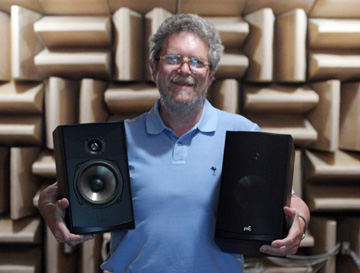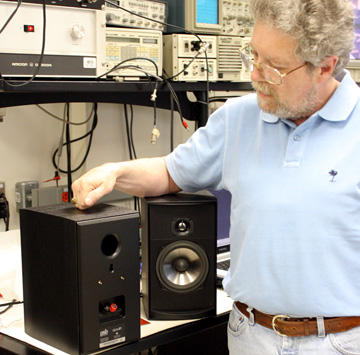![[SoundStage!]](../sslogo3.gif) The Traveler The TravelerBack Issue Article |
|
July 2006 Professor Paul and the PSB Alpha B1
Each time I visit Paul Barton while he's at the NRC, I learn something. The first time I visited him there was about six years ago. He was in the middle of designing some loudspeakers, but he took over an hour out of his time to explain to me in great detail exactly how one goes about measuring the output of a loudspeaker properly. He followed it up with a demonstration. Another time, we had lunch in the NRC's cafeteria, and when we returned to the lab I received a lengthy dissertation on diffraction. Paul explained exactly how it occurs, how it shows up in measurements, and how it affects what we hear at the listening chair. And then another time -- well, I could go on and on with all that Paul has told me, but suffice it to say, he is one of the legends of the loudspeaker industry for good reason: Few people know the ins and outs of loudspeaker design as well as Paul. So, if you have a question, no matter how obscure, he'll have an answer, which is why I’ve nicknamed him "Professor Paul." That name is not just because of his knowledge, though. He has a way of dispensing information so that even a layman can understand what he's saying. No matter how tricky the concept, Paul will make sure you grasp it before he's finished. It was no surprise, then, that when I arranged a quick meeting with Paul in June, it turned into a learning experience. It was just supposed to be simply a quick "hello" during which I would give him a pair of loudspeakers (the PSB Image T45s that Philip Beaudette reviewed this month). I was in charge of having the speakers measured at NRC, where Paul still does a lot of his design work. He gave to me another set of speakers that we are going to review and measure (the Alpha B1s), but one thing led to another and we were once again steeped in a discussion of various facets of loudspeaker design. We touched on some aspects of brand-new products he is working on -- top-secret, hush-hush kind of stuff that I'm probably not really supposed to know about -- but mostly we talked about the Alpha B1 bookshelf speakers. The topic eventually arrived at what Paul believes is a significant aspect of the new Alpha series: the difference between a vacuum-formed polypropylene cone, which the old series used, and an injection-molded polypropylene cone, which the new series uses. Of course, mentioning it is not enough. Paul explained processes that, frankly, most consumers who buy the speakers will be completely unaware of. The Alpha series is PSB’s entry-level speaker lineup, and the B1 is priced at $279 per pair. I consider the B1 to be the smallest practical two-way speaker that you can buy from PSB for a stereo system. I say "practical" because although there is a smaller, less-expensive two-way in the lineup, the LR1, that speaker is really small and more than likely quite light in the bass, so you’re probably going to need a subwoofer to make it sound rich enough to be musically satisfying. On the other hand, the B1 is a rear-ported design with a 5 1/4" woofer that gives the speaker a -10dB point of 55Hz. Naturally, Paul also explained the NRC's findings with regard to the significance of the -10dB point, but I won't go into that here, despite the fact that it was quite enlightening. Although 55Hz certainly doesn't translate to whomping bass, I’ve listened to quite a few speakers with similar bass extension and they’ve been "full enough"-sounding for music, at least for me. So, that’s why we picked the B1 to review on SoundStage! -- well, that as well as its price. These two things make it the kind of speaker that budget-minded audiophiles look for, particularly if they’re just starting out in high-end audio. But the dissertation that day on vacuum-formed versus injected-molded cones didn't have to do with bass extension; instead, it had to do with woofer consistency, which Paul says improves sonic performance in another way.
On the other hand, injection-molded cones are much more consistent -- virtually identical -- and that, Paul stresses, gives the new Alpha series better performance over the old. (The fact that he worries about such things for a speaker that costs less than $300 per pair shows you why Paul is not only considered the grandfather of the Canadian loudspeaker industry, but the king of budget speaker designs as well.) He mentioned other things that have been incorporated into the redesigned B1s, like the coating on the woofer (a vapor-deposit metal coating) and the cabinet itself. When it comes to the cabinet, I first thought that Paul was just talking about the slightly rounded sides and the slick metal grille, both of which make the B1 look better. That's part of it. But he was mostly talking about the solidity of the cabinet. It's made from MDF on the top, bottom and sides, and it uses a thick plastic baffle and back plate, which he demonstrated by knocking on it hard. Although this is a crude test, it did show the cabinet to be quite inert and well braced inside, including the port tube, which can resonate if it's not properly implemented. In the new Alpha series, Paul has coupled that tube to the cabinet, making for a rock-solid, dense enclosure throughout. As I mentioned, this is impressive engineering for a pair of speakers that costs less than what many audiophiles pay for interconnects. Once again, a quick trip to drop off and pick up some speakers winds up being a learning experience. I consider myself lucky, though, because it's a rare opportunity to have access to a facility as advanced as that of NRC, and to have one-on-one discussions with someone with the credentials of Professor Paul. Look for a full review of the Alpha B1s by fellow writer S. Andrea Sundaram in the fall, with additional listening impressions from me. And, of course, there will be our NRC-sourced speaker measurements to accompany it all. ...Doug Schneider |
|
|
|
![[SoundStage!]](../sslogo3.gif) All Contents All ContentsCopyright © 2006 SoundStage! All Rights Reserved |

 According to
Paul, when woofer cones are vacuum-formed, they start life as a large, flat sheet of
polypropylene. That polypropylene sheet is then sucked down in various spots to form the
cones, and the cones are cut away from the rest of the sheet. However, cones formed by
this process are inconsistent; one won't be exactly the same as another. He says that you
can see it, measure it, and hear it -- and the biggest impact that this inconsistency has
is compromised soundstaging and imaging. According to Paul, "The best stereo
soundstage comes from the best-matched loudspeakers."
According to
Paul, when woofer cones are vacuum-formed, they start life as a large, flat sheet of
polypropylene. That polypropylene sheet is then sucked down in various spots to form the
cones, and the cones are cut away from the rest of the sheet. However, cones formed by
this process are inconsistent; one won't be exactly the same as another. He says that you
can see it, measure it, and hear it -- and the biggest impact that this inconsistency has
is compromised soundstaging and imaging. According to Paul, "The best stereo
soundstage comes from the best-matched loudspeakers."